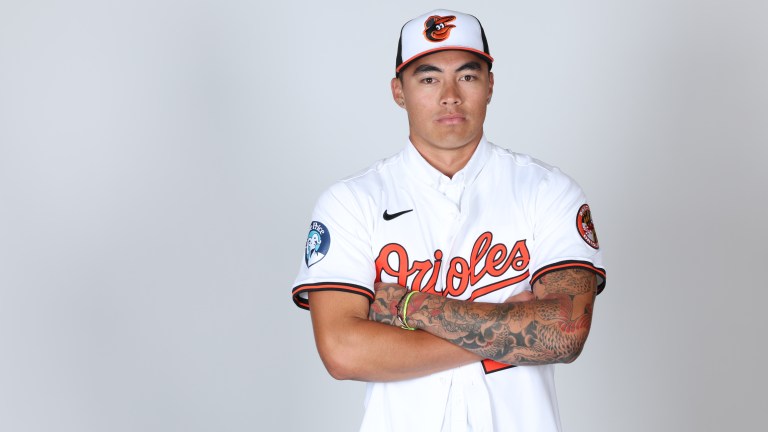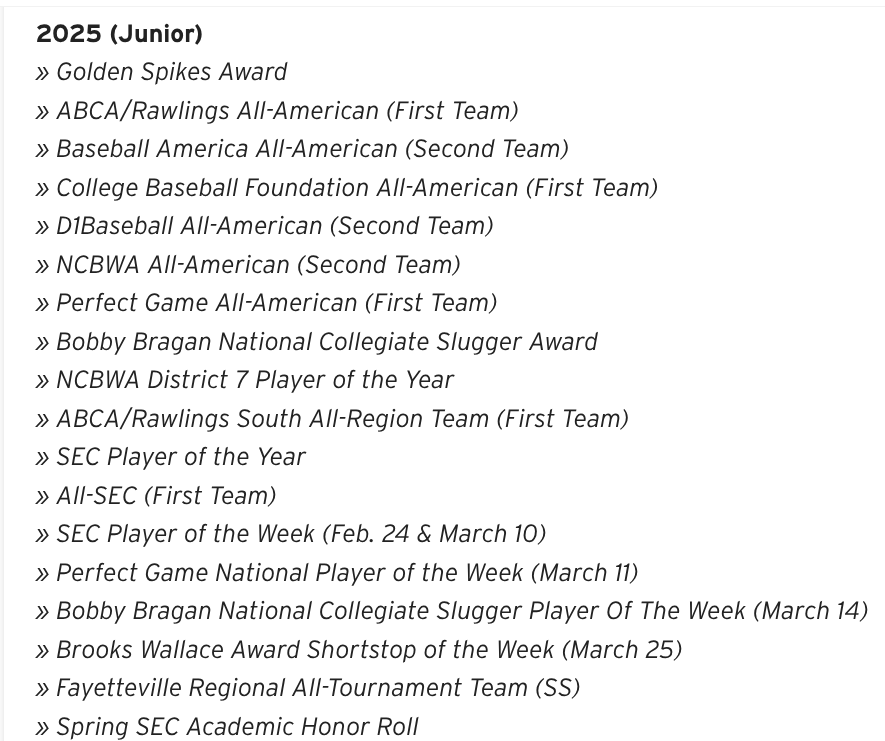How the Orioles Got “The Prized One” at Pick 31
The Orioles landed Golden Spiked winner Wehiwa Aloy with the 31st pick. So, how did the O's land the shortstop so late in the draft?

The Baltimore Orioles entered the MLB Amateur Draft primed to reload their farm system that saw several top prospects recently graduate. Their $19,144,500 bonus pool, thanks to trading reliever Bryan Baker to the Tampa Bay Rays a few days prior to the draft, was the largest in the draft’s history.
Baltimore had seven picks across the first two rounds of the draft, with four in the first round. Their third pick of the night went to Arkansas shortstop Wehiwa Aloy, whose first name means “The Prized One.”
This spring, Aloy was presented the Golden Spikes Award, college baseball’s equivalent to the Heisman in college football. Aloy is the third Golden Spikes winner that the Orioles have drafted following Ben McDonald in 1989 and Adley Rutschman in 2019.
The Hawaiian shortstop slashed .350/.434/.673 across 65 games for the Razorbacks. His 21 longballs ranked fourth highest in the SEC.
So, if he is the best player in college baseball, how come he lasted until pick 31?
Unless you a hardcore fan of the draft and its unique quirks compared to other professional sports drafts, this is an honest question that does not have a straight forward answer.
In this article, I will do my best to explain why players can fall in the draft and how Aloy’s selection indicates the future plans of the Orioles.
Aloha Aloy
The Golden Spikes Award is often compared to the Heisman Award in terms of its significance to the sport. While both awards do recognize the best players in their respective sport, the awards have differing levels of effects on draft stock.
Since 1978, only eight Golden Spikes winners have gone first overall. In the same amount of time, 13 Heisman winners have gone first overall and 22 have been top five picks.
On paper, Aloy has all the values you look for in a college player. During his junior year, the shortstop racked up a lengthy list of accolades.

Over his three years in college, the 21-year-old played in 181 games. Aloy also managed a .332 batting average and 1.016 OPS in his collegiate career.
The Arkansas shortstop also flashed a solid glove, recording a .978 fielding percentage in his final season at Arkansas.
Aloy also had a great run in the College World Series, hitting .375 with three extra base hit, including a two-run home run versus UCLA.
So, if the guy has had a great college career, played well in college baseball’s biggest stage and won nearly every award he could have this past season, why wasn’t he taken earlier in the draft?
The Fall to 31
In their last mock draft before the draft, Just Baseball writers Tyler Jennings and Jared Perkins projected Aloy to come off the board at 17 to the Chicago Cubs. The duo also noted that they could have seen the shortstop going as high as 11 to the Athletics.
In his MLB Draft Top 315 Prospect Big Board, Jennings had Aloy as the 20th-best prospect. So what happened that allowed the 21-year-old to fall to 31?
The main question surrounding Aloy’s game is the hit tool. Don’t get me wrong, hitting .350 in the SEC is pretty impressive. However, when stacking it up to the best of the best in the SEC in previous years, the average is the highest we have seen.
After transferring from Sacramento State at the end of his freshman season, Aloy hit .270 as a sophomore at Arkansas. A .270 average is good, but when it comes to high end college prospects, scouts are looking for much higher averages.
The Hawaiian shortstop posted a much higher .350 average this season, thanks in part to becoming more selective in his swing decisions. In his mock up, Jennings wrote that Aloy dropped his swing percentage to 43% in 2025.
If you have a high swing rate, it can be quite the uphill battle when you get into the minors – case in point, the O’s first round pick in 2024 Vance Honeycutt.
Honeycutt is known to be an aggressive guy at the plate. You cannot pull off swings like this if you are afraid to take your bat off your shoulder.
However, the former UNC outfielder has struggled mightily since being drafted. In 76 games so far this season, Honeycutt is slashing .172/.295/.266 along with 131 strikeouts.
So, while Aloy has shown impressive power in the premier college baseball conference, there could be worries that too much swing and miss could hurt his development. Making better swing decisions will help Aloy take better at-bats versus higher level pitching in the minors.
Aloy in the O’s Future
I want to take this chance to bring anyone who now has doubts about Aloy back on the hype train.
Whenever your team has the chance to take the best college player 31 picks into the draft, you must be happy with the selection, especially when they sign for their slot value.
Since it takes time for the prospects to make their way to the majors, unless you get drafted by the Angels, it is hard to see how these players fit into future plans for the team.
The Orioles already have an established young core infield of Jackson Holliday, Gunnar Henderson and Jordan Westburg. The Orioles are already having issues getting Coby Mayo playing time in the infield, so adding Aloy into the mix will make things even more challenging.
However, I think general manager Mike Elias wanted to use this draft as a way to quickly replenish the farm system in preparation for the O’s potentially making a run in 2026.
Elias has spent the entire year facing backlash for the signings he made to replace keys pieces to last year’s team. Replacing All Stars Corbin Burnes and Anthony Santander with Charlie Morton and Tyler O’Neill has proven to have been the worst possible choices he could have made.
If the Orioles are going to add a big name player it is most likely going to be from a trade. We know Elias is willing to pull the trigger. However, if Elias wants to hold onto Samuel Basallo and Coby Mayo, it would be hard to get a good player in return for the people the O’s have in their system.
By taking a lot of college players early on in the draft like Ike Irish, Caden Bodine and Aloy, Elias stocked up the farm with guys who have the potential to shoot through the minor leagues.
Come the trade deadline in 2026, there is a chance that these guys have made a name for themselves in the organization, and could be large bargaining chips for the Orioles front office that could be looking to add to a contending team.
While the 2025 trade deadline looks like O’s fans are going to have to say their goodbyes to some familiar faces, the O’s front office appears to have their minds set to what could come in a years time.
